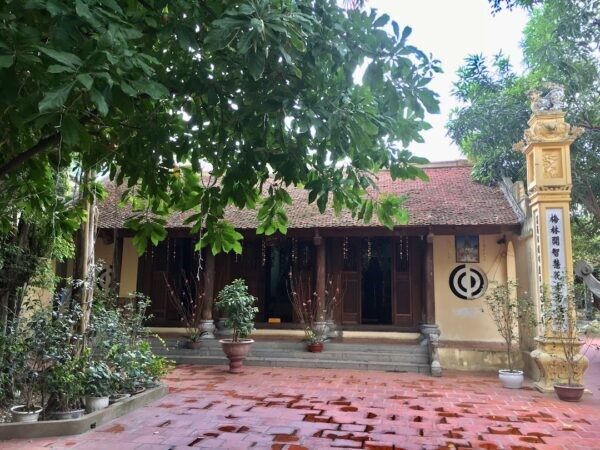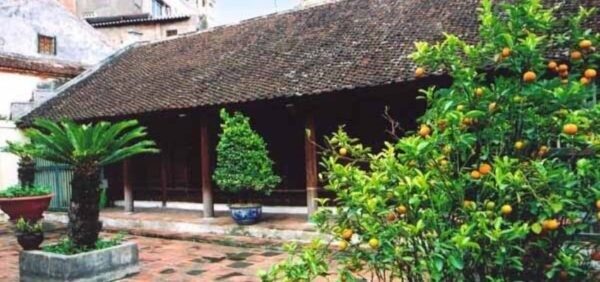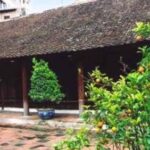Located in lane 205 Bach Mai street, Cau Den ward, Hai Ba Trung district, Huong Tuyet pagoda is a historical – cultural relic and also a revolutionary – resistance relic, which marked the period preparing all aspects of organization and force, towards the establishment of the Communist Party of Vietnam.

Huong Tuyet Pagoda
Huong Tuyet Pagoda was built in the early twentieth century, at that time in Hoan Long district, on the outskirts of Hanoi. The content on the worshiping stele at Huong Tuyet Pagoda was built in the Year of the Rat, the 6th Duy Tan era (1912), clearly stated: Mr. Nguyen Huu Quang in Hang Dao street, Dong Lac ward, with his wife Truong Thi Dieu, had the heart to buy a private garden in the territory of Bach Mai ward, Hoan Long district to build a temple to worship Buddha, along with the painting of statues, casting of bells… In the year of Pig (1911), in October, the good day the pagoda was completed and named “Huong Tuyet Tu” (Huong Tuyet Pagoda). The pagoda has a unique traditional architecture and interior decoration in compliance with Buddhist rites. The architectural complex of the pagoda includes the main pagoda, the ancestral house, the mother goddness house, the guest house.

Huong Tuyet ancestral house
The main pagoda follows the “tien nhi, hau dinh” style, including the front, middle and upper halls. The front and middle houses are arranged in parallel with the “Nhi” shape, similar in size and design, both of these houses have a plan of 5 compartments, built in the style of a back wall. The front house has a simple architectural structure. The rafters, beams and lines were polished. On the top of the rafters, beams and lines are embossed with simple decorative motifs such as asterisks and repeated plant leaves.
Upper hall consists of three vertical compartments, connected to the middle is the Trung Duong house with 4 sets of structural trusses in the style of stacking gong racks, all smoothed and lined. Particularly in the middle of the upper hall, there are two paintings of the srolls, which are structured in the style of the temple, on the scrolls are embossed with the theme of dragon rolling water, with elaborate carvings, artistic value, and bold imprints. of architectural art of the Nguyen Dynasty in the 20th century. The Mother Goddess House and the Ancestral House are both structured in a traditional architectural style and the interior decoration adheres to the worshiping rites commonly encountered at other religious monuments.
Huong Tuyet Pagoda still preserves many precious relics: bronze bells, stone steles of the Nguyen Dynasty and over 50 round statues, created around the first half of the twentieth century by carving dedicatedly with the four supernatural creatures, dragons and tiger edema. These artifacts have both content meaning and artistic value for the monument. Besides the Buddha statues, there are also Mother Goddess Goddess statues with artistic value. Along with typical relics made of wooden materials, including: horizontal lacquered board, screw-shaped ornament, solution and so on that curved with the four supernatural creatures, dragons and tiger edema. All are painted with gilded vermilion, which has increased the magnificence and splendor of Buddhist architecture at Huong Tuyet Pagoda.
Huong Tuyet Pagoda was not only a cultural relic, but also a relic of the Hai Ba Trung district’s resistance revolution. Huong Tuyet Pagoda was the Vietnam Revolutionary Youth Association’s contact point in 1929, and the action base of comrades Nguyen Duc Canh, Do Ngoc Du, Tran Hoc Hai, Nguyen Phong Sac, Tran Van Cung… The pagoda also housed the strike committee for the Aviat manufacturing workers. The policy, which directed workers to struggle, was delivered directly to the Committee by Comrades Nguyen Phong Sac and Ngo Gia Tu (from May 28, 1929 to June 10, 1929). This was a crucial battle in the formation of the Vietnamese revolutionary movement in general, and the workers’ movement in particular. With a new level of qualitative transformation, from spontaneous struggle to organized voluntary struggle, under the leadership of the Red Union, the predecessor of the current Vietnam General Confederation of Labor. The relic of Huong Tuyet Pagoda and the struggle of Aviat in Hanoi were considered as the direct driving force behind the wave of revolutionary struggle of our people, leading to the birth of the Indochinese Communist Party (June 17, 1929) the main nucleus of the Communist Party of Vietnam, established on February 3, 1930. Under the leadership of the Red Union, the predecessor of the modern Vietnam General Confederation of Labor, there was a new degree of qualitative transition, from spontaneous fight to organized volunteer struggle. The Huong Tuyet Pagoda relic and the Aviat struggle in Hanoi were regarded as the direct driving forces behind our people’s wave of revolutionary struggle, leading to the birth of the Indochinese Communist Party (June 17, 1929), the main nucleus of the Communist Party of Vietnam, established on February 3, 1930.
Aviat workshop was the largest auto repair and trading workshop in the North in the early 20th century, located on Rialan Street (now 16-18 Phan Chu Trinh Street) with more than 200 workers. Under the leadership of Comrade Ngo Gia Tu, Aviat workers fought fiercely to raise wages, abolish violence, and not allowed to fire workers joining the strike… Workers in Nam Dinh, Hai Phong, Hon Gai, Mao Khe, Vinh, Ben Thuy, Ha Dong, Ninh Binh… unanimously support Aviat workers to fight for 12 days and win.
Huong Tuyet Pagoda was an attractive place to visit for tourists near and far, especially history fans. Coming here, visitors can not only discover the architectural beauty but also gain more knowledge about a revolutionary historical place, related to the preparation period for the establishment of the Communist Party of Vietnam.
Thanh Ha

